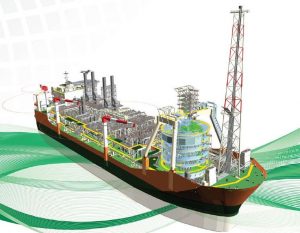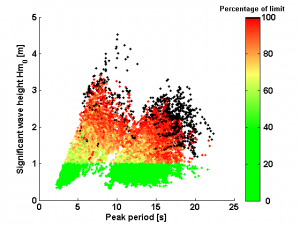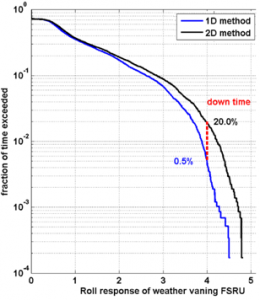Vessel Motion Response by Waves, Wind & Currents
One of the key challenges in Engineering design is the selection of critical conditions for simulation. Taking combinations of extreme conditions from Extreme Value Analysis (EVA) of metocean data doesn’t necessarily give the determining condition (e.g. the floating system may respond strongly for a wave period associated with a lower extreme wave height). Aktis has the facility to make dynamic simulations of the motions and loads for large numbers of combinations of metocean parameters (including time series). For many maritime applications however, the design loads are not determined by the metocean conditions itself as well as by the dynamic response behaviour of the floating structure under influence of environmental forcing.

Examples are listed below:
Channel Depth & Access Channel Design
Aktis Hydraulics has tools for designing channel depth ranging from very simple approaches to sophisticated probabilistic design accounting for all the important factors. This is underpinned by in depth knowledge of:
- Wind, waves, currents and tides;
- The vertical movement of the ship in response to waves and the associated distributions;
- Squat, trim and wind and turning induced heel;
- The effect of winds and currents on the orientation of the ship.
The use of a sophisticated admission policy, allows ship access for a higher percentage of the time with a higher degree of safety than a simple system based on a limited number of simple criteria. A consequence of this is that the required dredging will be less when a sophisticated admission system is applied. An example of such a system is PROTIDE (see Bos, Koop & Bolt, PIANC 2011), as applied for the ports of Amsterdam, Rotterdam, Eemshaven, Zeeland (NL), Antwerp (BE), Emden (DE) and Port of Longbeach (USA).
The result of a typical study is typically a recommendation for the minimum dredged depth of an access channel for a particular safety level (e.g. the probability of any ship touching the seabed in a 25 year period is less than 10%).
Click HERE for more information.
Parametric roll & broaching to
The stability of the vessel depends on the wetted hull and resulting restoring forces. Under the influence of relatively high and long wave crests travelling along the vessel the stability may vary. Under wave excitation and for specific combinations of pitch and roll response of the ship, the variations in stability may lead to an excited roll oscillation known as parametric roll.
Aktis Hydraulics has access to historic database for all locations in the world and is able to address the 2Dimensional spectra (energy density per frequency and direction) on a very fine temporal and spatial resolution to replicate (potential) parametric roll incidents.
This animation shows the observed result of one of those investigations.
Similar to paramatric roll, Aktis Hydraulics is well positioned to support investigations into events that may be attributable to:
- Broaching to;
- Surf riding;
- periodic (synchronous) oscillations;
- Capsizing.
LNG and FSRU: Ship-to-ship and evaluation of Critical Accelerations & motions
We evaluate the motions of a multi-body system in response to winds, waves and currents using our Dynamic Mooring Analysis software (DMA). It also accounts for thehydrodynamic interactions between adjacent ships. DMA can be used to analyse the fully non-linear motion response of a side-by-side moored LNGC and FSRU for turret moored weathervaning systems, spread moored systems and FSRU’s moored at a jetty. Typical results are:
|
 |
A critical aspect affecting the reliability of the results is the fidelity with which the metocean conditions are represented. For example, if there are cross seas or large differences in wave and current direction, the FSRU and LNGC may be subjected to beam waves. In general, these have a much worse effect on the availability than head waves. The strong point of Aktis’ approach is the availability of all aspects (coastal metocean conditions, ship hydrodynamics and ship response) that determine the outcome.
For more complexe mooring systems with multiple caneraries, clump weights, TLP and SPM we are well positioned to wield Orcaflex.
Motion response for transport and lashings
Aktis Hydraulics has experience in the application and evaluation of the various transport guidelines in relation to optimising transports. By optimising the voyage accounting for seasonal variations in the climate we can evaluate the feasibility and workability for the planned transport and provide structural design criteria including maximum expected accelerations and critical motion response such as heel angle, and statistics on roll and pitch motions to be expected en-route.
Together with BMT Argoss we can offer these services not only in a desk-evaluation and recommended practise, but also support the operation phase.
By using ANSYS AQWA we are able to evaluate the motion response of various vessels and objects, including the following examples:
- Barges
- Heavy Lift vessels
- Roll-on/Roll-off vessels
- (submerged) tunnel elements
Click HERE for an example project.
Heading analysis
To correctly perform a heading analysis, one needs to simultaneously evaluate the acting environmental conditions. In a typical heading analysis the range of the potential orientations of the vessels can be established and the angles of incidence of the different actors can be addressed. For typical tankers and FPSO that have a stable orientation, the analysis may end here.
Assymmetrical ship (underwater) hulls and a-typical ship configurations may result in so-called fish-tailing phenomenon. Over the past years our team has come across this undesirable motions for various objects, including Single Point Mooring (SPM) systems whereby:
- cruise ships & yagths having the superstructure abow;
- FSRU having the factory abow;
- Trimmed & ballasted shuttle tankers, where the wind catches the elevated bow;
- Towed Tunnel Elements – with high block coefficients creating unstable hull flow coefficients;







